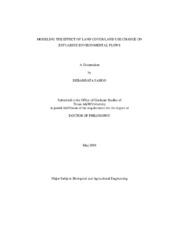| dc.description.abstract | Environmental flows are important to maintain the ecological integrity of the estuary. In
a watershed, it is influenced by land use land cover (LULC) change, climate variability,
and water regulations. San Antonio, Texas, the 8th largest city in the US, is likely to
affect environmental flows to the San Antonio Bay/Guadalupe Estuary, due to rapid
urbanization.
Time series analysis was conducted at several stream gauging stations to assess trends in
hydrologic variables. A bootstrapping method was employed to estimate the critical
value for global significance. Results suggested a greater number of trends are observed
than are expected to occur by chance. Stream gauging stations present in lower half of
the watershed experienced increasing trend, whereas upper half experienced decreasing
trends. A similar spatial pattern was not observed for rainfall. Winter season observed
maximum number of trends. Wavelet analysis on hydrologic variables, suggested presence of multi-scale temporal
variability; dominant frequencies in 10 to 15 year scale was observed in some of the
hydrologic variables, with a decadal cycle. Dominant frequencies were also observed in
17 to 23 year scale with repeatability in 20 to 30 years. It is therefore important to
understand various ecological processes that are dominant in this scale and quantify
possible linkages among them.
Genetic algorithm (GA) was used for calibration of the Hydrologic Simulation Program
in FORTRAN (HSPF) model. Although, GA is computationally demanding, it is better
than manual calibration. Parameter values obtained for the calibrated model had physical
representation and were well within the ranges suggested in the literature.
Information from LANDSAT images for the years 1987, 1999, and 2003 were
introduced to HSPF to quantify the impact of LULC change on environmental flows.
Modeling studies indicated, with increase in impervious surface, peak flows increased
over the years. Wavelet analysis pointed, that urbanization also impacted storage.
Modeling studies quantified, on average about 50% of variability in freshwater inflows
could be attributed to variation in precipitation, and approximately 10% of variation in
freshwater inflows could be attributed to LULC change.
This study will help ecologist, engineers, scientist, and politicians in policy making
pertinent to water resources management. | en |


